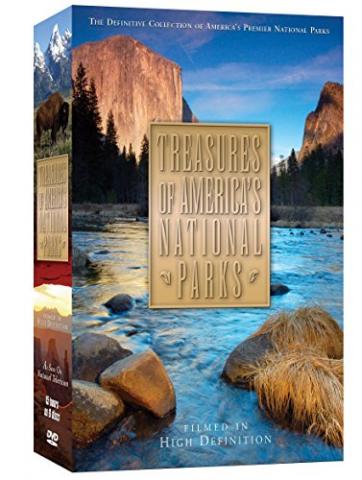Before Ken Burns and Dayton Duncan came out with their view of the National Park System, many others were turning their cameras on the parks. One collection I've found that is worthy of space in your DVD collection is Treasures of America's National Parks, a six-disk collection (MSRP $39.99) of some of the system's icons.
Spanning 15 hours, this July 2008 compilation was pulled from a series that ran on the Travel Channel. Filmed in high definition, the programs take you through Yosemite and Yellowstone national parks, down into the Grand Canyon and across Arches and Canyonlands, up to Glacier and even farther north into the Canadian Rockies to explore Banff and Jasper national parks.
Part of the beauty of these DVDs, other than the high-definition videography, is that they combine travelogue, educational content, and what-to-see pointers. For instance, how many of you know that the Pine Creek Bridge in Zion National Park contains rock work that reflects all the different colors of sandstone found in the park? Or about the canyoneering options in Zion?
An unusual aspect of the Yosemite episode is a look at the hang-gliders who launch onto the skies above Yosemite Valley. That's not something your typical guidebook explores. You also learn that the High Sierra Tent Camps that dot the park's backcountry date to 1923, and are treated to some great historic footage of climbers on El Capitan. And, of course, this video touches on the debate over turning Hetch-Hetchy into a reservoir to both slake the thirst and help power San Francisco.
The segment on Grand Canyon National Park places you on the back of a mule and takes you down into the canyon, and there's also a portion that explores hiking down into the canyon.
As with the Burns production, The National Parks: America's Best Idea, this series approaches its task by mixing historic and current footage on the parks. Time, though, does allow some errors to create in. For instance, the piece on Zion mentions the American Orient Express ... which went bankrupt in August 2008. That, of course, is an error the producers could not have envisioned when they first filmed this segment.
Overall, the wealth of this collection is not only that you can revisit your favorite parks over and over and over again, but also that there is that educational component to the series. Human history, wildlife, and geology all are touched on in the DVDs, which help give you a better primer on these special places than one that simply shows the tourist-related destinations.
Fringe benefits of the set are supporting episodes that take you bear watching in Alaska; floating the Snake River in Grand Teton National Park; offer a peek at some of the National Park System's iconic lodges, such as the Old Faithful Inn and The Ahwahnee, and; reveal some isolated natural pools in Hawaii's national parks to soak in. The episode on Extreme Maintenance in the parks is another great addition. It takes you into the parks with firefighters, to Mount Rushmore National Memorial to see how the presidents' faces are cared for, to Glacier National Park for plowing the Going-to-the-Sun Road, and elsewhere to show just what it takes to maintain the park system.
If there is a shortcoming, it's that the collection sticks almost exclusively to the Western parks. One of the DVDs, The Best of the National Parks, takes a look at Acadia, Mammoth Cave and Everglades national parks, but just via short glimpses, and there are other park classics, such as Great Smoky Mountains National Park, the Blue Ridge Parkway, and Shenandoah National Park, that are missing.
Still, pair this 15-hour collection with Mr. Burns' 12-hour series and you're well on your way to building a very substantial video library on the national parks.








Comments
I think these productions are sparking Americans to visit their parks. Our visitation sure seems up. Hope we don't love them death.
Our National parks are real treasures, we have been to see/camp/dine/hike in 116 Parks and Monuments. My one beef relates to the campgrounds that do not have electric for the RV units used by many seniors. Coulter camp in the Tetons has a good idea, a large area where generators are allowed and a large area where no generators are allowed, at least this is a start.
To my thinking, having electric in some of the campsites, reduces Noise pollution, reduces carbon pollutions and makes for better camping neighbors. Of course an extra charge for electric sites is expected.
Also the reservation system need some changes: 1- reservable sites should be limited to no more than 50% of the sites as many of us travel freely about the states and do not know where we will be in 2-3 weeks from any certain date because of weather and sometimes health conditions. 2- Why do those that do not reserve, pay a reservation fee of 2-3 dollars for a site they use on a drive up basis?
This reservation changes should apply to Core Of Engineers as well and/or all Gov. controlled land usages. One Park we were in in Pa. the reserved sites were taken every weekend by the locals, so we had to take a dry camp site the weekend nights. Show some respect for the elderly, Please.
Relating to state parks, Please keep rates minimal as the campers support the local economies to the tune of $50 a day or even more. This is income for your state!
Thanks for lending me your ear. Richard